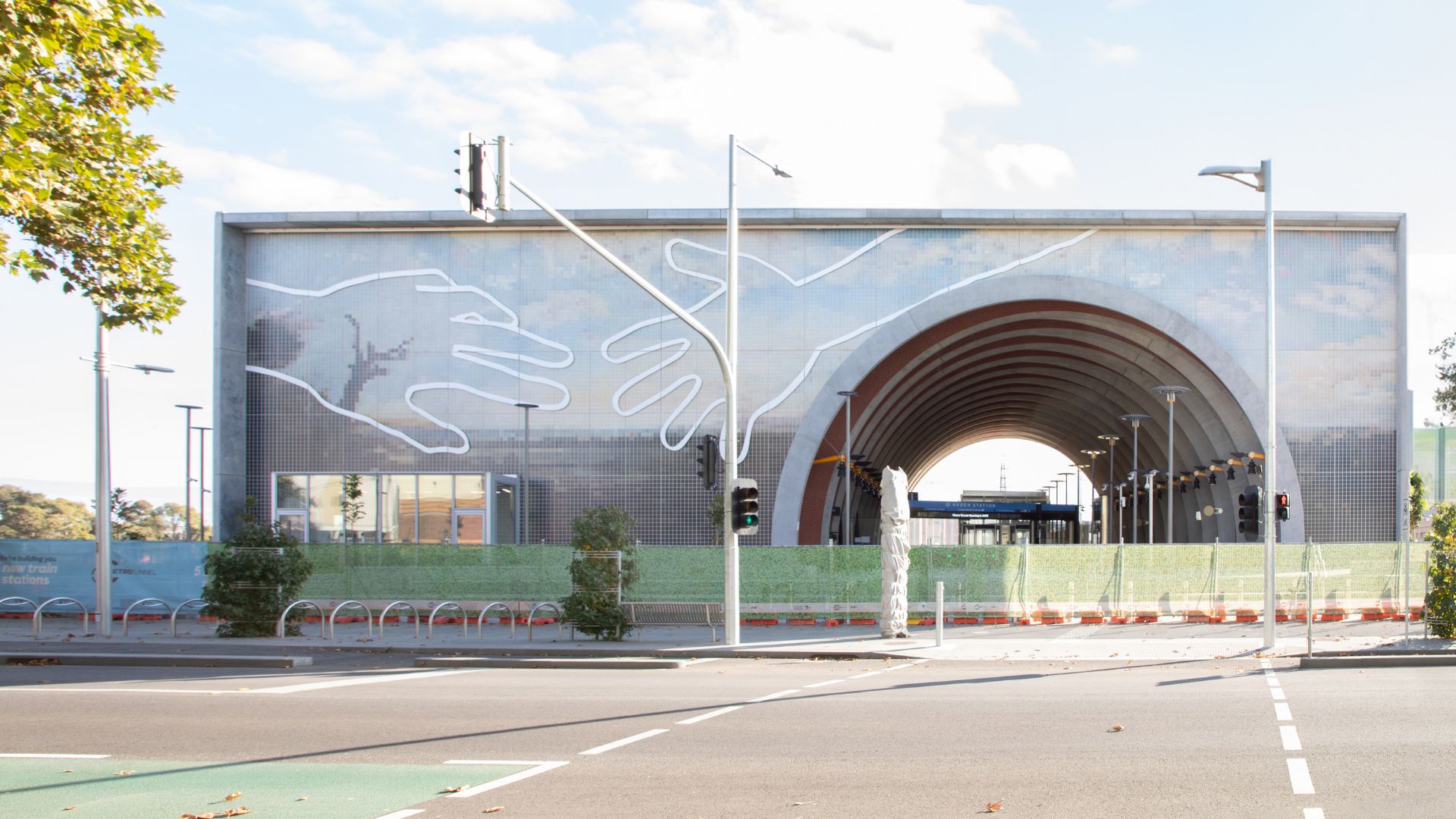Eighty years since the first of a beloved fleet of trains was introduced to the world, a national blue plaque is being unveiled at the redbrick house in Gloucestershire where the Rev W Awdry worked on his railway stories.
Blog
-

Blue plaque to be unveiled at home of Thomas the Tank Engine creator | Heritage
The blue plaque to be… -

Active Surfaces® purify the air at a Melbourne train station : DesignWanted
Train stations in city centres are urban areas often associated with dirt and pollution. However, in the heart of Melbourne, a railway station is quietly cleaning the air around it. The Arden Station façade actively fights pollution, kills…
Continue Reading
-

Alzheimer’s And Cancer May Soon Be Treated With Sounds We Can’t Hear : ScienceAlert
Sound waves at frequencies above the threshold for human hearing are routinely used in medical care.
Also known as ultrasound, these sound waves can help clinicians diagnose and monitor disease, and can also provide first glimpses of your…
Continue Reading
-

Embry-Riddle, Brazilian Researchers to Tackle Challenge of Keeping Electric Aircraft Cool
Researchers at Embry-Riddle Aeronautical University and Brazil’s Instituto Tecnológico de Aeronáutica (ITA) will combine forces on one of the main challenges of electric aircraft — controlling the heat spikes they generate at takeoff.
The collaboration is supported by a $450,000 National Science Foundation International Research Experiences for Students (NSF IRES) grant.
“Both sides have been working on the heat management challenge, so there are some real synergies,” said Dr. Sandra Boetcher, the interim department chair and professor of Mechanical Engineering and principal investigator on the project. Boetcher is working with co-principal investigator Dr. Mark Ricklick, associate professor of Aerospace Engineering, as well as Brazilian colleagues Dr. Guilherme Borges Ribeiro and Dr. Elisan dos Santos Magalhães.
The collaboration is intended to offer hands-on research training to students, preparing them to tackle the issue of heat management on electric aircraft, considered key to reducing the aviation industry’s carbon footprint. The project will involve three cohorts of five Embry-Riddle students over the next three years spending eight to ten weeks between May and August in Brazil at ITA.
Boetcher said the heat management research that she and Ricklick undertake tends to be fundamental, developing prototypes, for example, that can be further tested. Similar research out of ITA, which is affiliated with the Brazilian Air Force and the Brazilian multinational aerospace corporation Embraer, tends to be applied.
One of the main technologies the researchers from both countries are exploring relates to phase-change materials, which convert from a solid to a liquid at certain temperatures and are capable of absorbing large amounts of heat during the process.
Drs. Sandra Boetcher and Mark Ricklick, standing in front of an aircraft turbine, received a $450,000 NSF grant to offer a student research collaboration with Brazilian colleagues on heat management of electric aircraft. (Photo: Sandra Boetcher)In a phase-change process, energy, in this case heat, is expended on overcoming the molecular forces holding a solid structure together, changing the material to a liquid. No temperature rise occurs during the change. This happens in everyday phase changes, Boetcher explained.“It’s like you’re melting an ice cube,” she said. “The ice cube is melting, but the temperature stays the same,” until the ice cube becomes water and the water’s temperature starts to climb.
The phase-change materials being investigated by the researchers capitalize on the phenomenon and can be applied as a slab under an aircraft’s electrical circuit to keep it under a certain temperature.
Modeling to optimize the performance of phase-change materials with computer simulations can be time-consuming, with computational fluid dynamics problems taking as long as two weeks to solve.
Magalhães brings coding expertise that could “speed up the process of solving the problem,” Boetcher said.
The researchers will also look at other technologies to manage heat in electric aircraft, including ones that could provide active cooling rather than passive heat absorption.
Boetcher said she thinks the students who travel to Brazil will benefit deeply, even apart from participating in the technological innovations that could result.
“It’s dealing with other cultures, with other collaborators, how they view things, how they operate, how they work,” she said. “There’s a lot of maturing when you get to have these opportunities abroad.”
Dr. Jeremy Ernst, vice president for research and doctoral programs, further emphasized the value of the collaboration.
“The IRES program is impactful in creating research exposure and authentic international experience,” Ernst said. “The work led by Dr. Boetcher and Dr. Ricklick is of high value to students, offering enhanced cultural immersion in Brazil within its rich aviation and aerospace environment. This experience allows students to develop skills that are directly transferable to the global workforce.”
Continue Reading
-

This common morning habit is silently damaging arteries; can increase heart death risk by 87%, says study
How we start our mornings has a lot to do with how the rest of the day is going to go. From picking up mobile phones after waking up, to struggling to get that one cup of coffee, all morning rituals matter. At first, these might seem harmless…
Continue Reading
-

China’s biggest shopping event starts five weeks early to revive spending
It’s known to be China’s biggest online shopping event – taking place on 11 November each year.
But this year, Single’s Day sales have already begun in mid-October, as part of efforts by Chinese retailers to boost spending in a sluggish market.
China has been plagued with issues like growing youth unemployment , a prolonged property crisis, steep government debt and an ongoing trade war with the US – all of which is making the country’s consumers cut back on spending.
The Chinese government has been spending billions – through family subsidies, more wages and discounts for consumer goods in a bid to counter this, but retail sales growth is still failing to meet expectations.
Originally created by Alibaba as a Chinese shopping festival, Singles’ Day is akin to Amazon’s Prime Day or Black Friday promotions elsewhere in the world.
A major revenue driver in the final quarter of the year, the event is marked with deep discounts online and in stores, with most retailers in the country competing for sales.
Over the years, the sales window has evolved from a single day to one of the year’s biggest shopping events, often ushered in with extravagant opening events featuring popstars like Jessie J.
But this year, retailers launched their sales campaigns in October, coinciding with the end of China’s Golden Week holiday.
Platforms like Taobao, JD.com and Douyin are actively promoting “11.11” sales, with banners on their apps showing discounts and vouchers.
Alibaba, which runs e-commerce platforms Taobao, Tmall and AliExpress, said in its newshub that it is kicking off this years “11.11 Global Shopping Festival” on 15 October.
The firm is also tapping artificial intelligence in its search and recommendation tools to make it easier for shoppers to navigate its sprawling sites and suggest relevant products.
Chinese consumers have adopted more cautious spending habits since the Covid-19 pandemic – a trend that has continued as the country continues to battle deflation.
The spending crunch has hit high-end retailers especially hard. Fashion brands like Louis Vuitton and Burberry reported a drop in sales in recent months in China, which accounts for around a third of global luxury sales.
However, investors seem optimistic about a rebound in China’s market, as shares of luxury brands like LVMH and Moncler rose this week, lifted by signs of improved demand in the region.
Continue Reading
-
Palestinian Authority sets out three-phased Gaza reconstruction plans – Dawn
- Palestinian Authority sets out three-phased Gaza reconstruction plans Dawn
- Keynote adress by Prime Minister Dr. Mohammad Mustafa at the High-Level Meeting on the Situation in Gaza Islamabad Post
- Daily World Briefing, Oct. 17 Xinhua News
- Slowed…
Continue Reading
-

Central Banks Must Guide ASEAN+3 Through Age of Novel Risks – ASEAN+3 Macroeconomic Research Office
This article was first published in The Business Times on October 9, 2025. It was co-authored with Julia Bingler, Fellow at the Council on Economic Policies.
Authorities must revise capital frameworks and integrate resilience into monetary operations to tackle challenges
In just the last few months, novel risks have crystallized across ASEAN+3.
Grab merchants in Singapore began accepting stablecoin payments; Typhoon Bualoi flooded Philippine and Vietnamese ports and factories, paralyzing entire provinces; and US tariff increases are forcing regional economies to recalibrate supply chains.
These disruptions share a common thread: traditional economic frameworks cannot keep pace. Digital assets are reshaping monetary systems, social tensions are threatening political and economic stability, climate extremes are disrupting supply chains, and geopolitical shifts are upending trade patterns.
Policymakers must now simultaneously respond swiftly to immediate crises, such as rising living costs, geopolitical pressures and extreme weather events, while steering deeper structural changes involving demographic shifts, digital currencies, artificial intelligence (AI) and the transition to sustainable economies.
The prosperity of ASEAN+3 economies–the 10 Southeast Asian nations plus China (including Hong Kong), Japan and South Korea–hinges on whether policymakers, central banks and financial supervisors can navigate an increasingly complex landscape of novel risks that cut across food security, labor markets and infrastructure resilience, potentially undermining economic welfare and financial stability.
The rising likelihood of compound shocks adds complexity. But if tackled strategically, such policies can become catalysts for sustainable prosperity.
New risks require new approaches
Novel risks are not simply variations of known shocks. Most are cross-border, systemic and fraught with deep uncertainties, with a high likelihood of materializing concurrently.
Because they challenge conventional governance and risk management approaches, these risks require more adaptive and targeted instruments to safeguard financial stability, as well as to ensure price stability and sustainable long-term prosperity.
Conventional financial risk assessment models based on historical data and unrealistic assumptions cannot capture novel risks appropriately. Backward-looking stress testing is increasingly unviable. By their nature, these are risks that economies have not faced before, making forward-looking risk management and analysis essential.
Global systemic challenges at this level cannot be hedged or diversified away. When they crystallize, there will be wide cross-border implications.
Novel risks also put monetary policy under pressure. Stablecoins and climate change weaken monetary transmission channels and exacerbate existing vulnerabilities.
While fully pegged stablecoins promote financial inclusion for the under-banked and bridge traditional finance with the digital economy, they also amplify currency devaluation and weaken central banks’ ability to set monetary policy in line with domestic economic conditions. They could trigger capital flow volatility, liquidity shortfalls, and sudden devaluations that wipe out savings.
Climate change, meanwhile, will damage productive capacity, alter investment patterns and create inflationary pressures through supply shocks.
Financial authorities must step up
Finance ministers, central bankers and financial supervisors need new approaches to address these challenges.
Price and financial stability must now take into account forces that threaten stability beyond traditional business cycles. Without such adaptation, economic and financial governance frameworks risk losing their effectiveness.
Novel risks demand strategically recalibrated monetary policy, resilience-focused financial regulation and forward-looking supervision. Policymakers, central banks and financial regulators already possess powerful tools that – if deployed early and strategically – can help financial markets navigate these risks more effectively.
Several ASEAN+3 central banks are already leading the way with initiatives to manage the digitalization of financial services, strengthen regional payment systems, develop human capital, promote financial inclusion and support the transition to climate-resilient economies.
The Bank of Korea has created a virtual asset committee to monitor crypto developments and support legislation; the Bank of Thailand has completed consultation on its AI risk management policy; and the Monetary Authority of Singapore is developing a generative AI risk framework through Project MindForge. Japan has amended the Payment Services Act to introduce stablecoin licensing requirements, and Bank Negara Malaysia has launched a Climate Finance Innovation Lab while integrating climate risks into supervision.
However, these initiatives remain fragmented and often modest in scale relative to the magnitude of the risks ahead. The time has come to scale up, systematize the implementation of these measures and regionalize them.
Supervisors and regulators need to revise capital adequacy frameworks to reflect novel risks, and issue explicit guidance on how institutions must incorporate them into strategies.
Disclosures must deliver decision-useful, forward-looking information. Systemic capital buffers need calibration to reflect the likelihood of risks materializing simultaneously. Regional collaboration will be critical to avoid regulatory arbitrage and fragmentation.
For monetary policy, central banks need to integrate resilience directly into refinancing operations and asset purchase programs. They must reflect novel risks in collateral frameworks and balance sheet management, including foreign reserve holdings.
Regional cooperation essential
ASEAN+3, as a region of diverse economies bound by deep interdependence, faces unique challenges.
Risk spillovers are inevitable, and no single nation’s measures will suffice. A prolonged heatwave in one country disrupts food supply chains in another. Capital mispriced in one jurisdiction creates vulnerabilities across the regional financial system. A rapid shift to US dollar stablecoins could weaken monetary policy effectiveness and create sudden liquidity shortfalls.
To deal with these risks, both individually and simultaneously, the region must monitor developments, meet regularly to coordinate policy actions, and develop internal capacity to understand and manage them.
By pooling expertise as well as developing common standards and interoperable regulatory frameworks, ASEAN+3 policymakers can transform a patchwork of responses into a regional architecture of resilience.
Finance ministries and central banks have long been the guardians of economic and financial stability. In this new age, they must also become architects of resilience and enablers of economic transitions.
Aligning financial supervision and monetary policy with novel risks is not a technocratic exercise. It is a strategic choice that will define whether regional economies can achieve sustained growth, mitigate emerging risks, enhance social welfare, and benefit from climate-resilient prosperity in the decades ahead.
ASEAN+3 can provide an example of global best practice, leading in setting the framework and institutional arrangements necessary to monitor and manage novel risks.
Continue Reading
-

Rogue black hole shocks astronomers with record radio blast
For the first time, scientists have observed a tidal disruption event (TDE) — a phenomenon in which a black hole rips apart a passing star — taking place outside the central region of a galaxy. This unusual discovery revealed powerful and…
Continue Reading
-

New insights explain the mechanics behind deep breaths and lung relief
More than half of all premature babies born before the 28th week of pregnancy develop respiratory distress syndrome shortly after birth. As their lungs are not yet fully developed, they produce too little of the seemingly magical…
Continue Reading